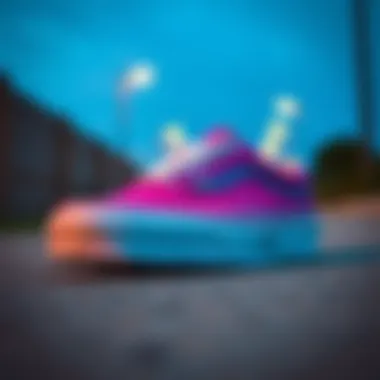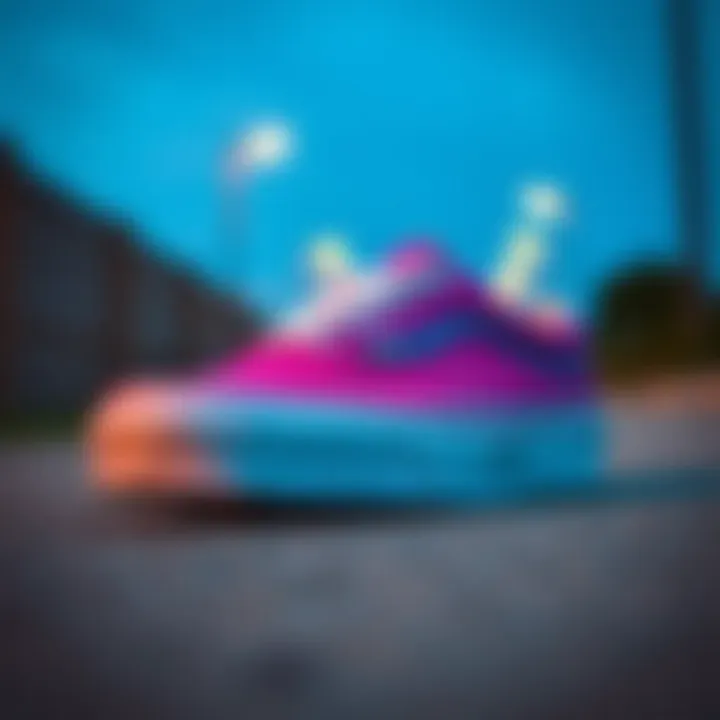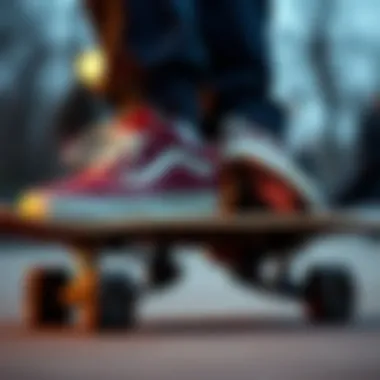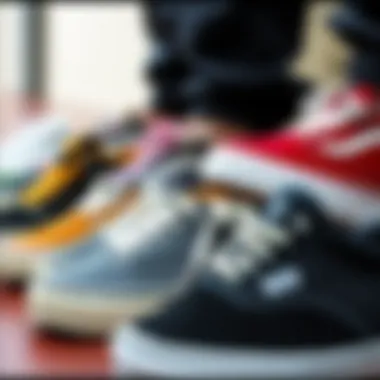Exploring Low Top Vans Shoes: A Complete Guide


Intro
Low top Vans shoes have become more than just a preferred footwear choice among skaters; they’ve woven themselves into the very fabric of skateboarding culture and style. Known for their iconic silhouette, these shoes have earned a spot in the hearts of skateboarders and trendsetters alike. To truly appreciate the impact of low top Vans, one must look beyond their appealing design. This journey will reveal the roots, flexibility, and cultural relevance of these sneakers, as well as the ways they resonate within the community.
Whether you’re lacing up for your first skateboard trick or simply seeking to understand their cultural significance, there’s much to discover. From the craftsmanship involved to the varied styles available, this guide aims to dissect every aspect, providing insight into why low top Vans have maintained their spot at the forefront of both performance and fashion.
Let’s roll on into the essentials.
Essential Skateboarding Gear
Skateboarding is all about the right gear. Having the right equipment can make a noticeable difference in both performance and safety, especially for newcomers. When considering footwear, low top Vans shoes very much steal the thunder, but let’s look at some other components that complete a skater’s setup.
Top Picks for Skateboards and Accessories
Selecting the right skateboard is pivotal. Many elements play into the choice:
- Deck: Choose a sturdy deck to support your skills. Brands like Element or Baker are consistently recommended by seasoned skaters.
- Trucks: Lightweight trucks from Independent or Thunder can enhance your control.
- Wheels: The hardness of the wheels affects grip. Softer wheels, around 78A to 90A, are perfect for rough terrains, while harder options are ideal for smooth surfaces.
- Bearings: A reliable bearing, such as those from Bones, ensures a swift ride.
- Safety Gear: Helmets and pads from brands like Pro-Tec safeguard against nasty falls.
Choosing these essentials wisely often differentiates between casual skating and carving it up at a park. Having the right skateboard not only improves performance but elevates the overall experience.
Maintenance Tips for Longevity
To keep your skateboarding gear, particularly your shoes, in peak condition, a bit of routine care goes a long way. Here are some practical tips:
- Regular Cleaning: Use a damp cloth to wipe off dirt, especially from the rubber soles of your Vans.
- Proper Storage: Keep shoes away from direct sunlight to prevent fading and avoid buckle up overly tight after a ride to help maintain their shape.
- Check for Damage: Frequently inspect the shoes for loose stitching or wear and tear, addressing issues sooner rather than later can prevent further damage.
By maintaining both your shoes and skateboard, you'll be able to enjoy smooth sailing and keep your style sharp.
Skateboarding Tricks and Tutorials
As equipment and gear form the base of a skater’s experience, mastering tricks unlocks deeper levels of expression. Knowing the fundamentals is essential, whether you’re just starting or looking to polish your craft.
Beginner Tricks to Get You Started
New skateboarders should focus on mastering a few key tricks to build confidence:
- Ollie: The bread and butter of skateboarding, the ollie is essential for jumping and grinding.
- Kickflip: Once you have the ollie down, adding a flip to your jump is the next step.
- Pop Shuvit: This trick helps you manipulate the board's movement under your feet while keeping it grounded.
Starting with these basic tricks provides a solid foundation for evolving into more intricate maneuvering.
Advanced Techniques for Seasoned Skaters
As you progress, techniques advance and become more complex:
- Heelflip: Similar to the kickflip but uses the heel to spin the board.
- Varial Flip: Combining a pop shuvit and a kickflip creates a stunning show of skill.
- 360 Flip: Gaining proficiency in both flips and rotations results in one of the most coveted tricks.
Being a skater means you’re continually learning. Those who embrace practice and perseverance often find a community that celebrates them.
"Skateboarding isn't just a hobby; it's a lifestyle and an art form that lets you carve your path."
The intricacies of skateboarding and the perfect kick on low top Vans shoes bring out unique expressions of artistry. Equipped with the right knowledge and gear, you’re set to ride into the world of skateboarding, leaving a mark that’s unmistakably your own.
Preamble to Low Top Vans Shoes
When discussing the landscape of casual footwear, low top Vans shoes hold a special place. These shoes are more than just a practical choice; they tell a story about youth culture, creativity, and the spirit of rebellion. With roots intertwined in the skateboarding scene, low top Vans have evolved to become a staple not only in skate parks but also in everyday fashion.
The importance of low top Vans lies in their versatility and cultural significance. They are ubiquitous among skaters, influencers, and even casual wearers who appreciate a laid-back style. This article aims to provide a comprehensive guide to understanding the essence of low top Vans shoes, focusing on their history, design, and practical considerations.
In exploring low top Vans, one must consider several key elements:
- Style Versatility: From classic black-and-white patterns to vibrant colors, these shoes adapt to a myriad of styles, making them easy to pair with different outfits.
- Functionality: Enthusiasts praise their practicality, especially in the context of skateboarding, where comfort and grip are paramount.
- Cultural Impact: The connection to the skateboarding community and the adoption by mainstream fashion lend a unique identity to low top Vans.
In essence, low top Vans shoes are not just footwear but a cultural phenomenon that transcends their original intent. Understanding their evolution provides insight into the ongoing dialogue between fashion and function, appealing to a diverse audience from skaters to fashionistas.
Defining Low Top Vans
Low top Vans are characterized by their flat, low-cut design, featuring a canvas or suede upper and rubber outsole. This simplicity is deceptive; they encompass a variety of nuances that cater to different tastes and preferences. Unlike their high-top counterparts, which provide ankle support, low tops offer more breathability and a sleeker silhouette.
A few notable features help define low top Vans shoes:
- Construction: Most models have a simple lace-up style, which allows for easy adjustments. They are light on the feet, suitable for all-day wear.
- Slices of Style: The iconic Vans logo and timeless pattern options—checkered, solid colors, or collaborations—allow for personalization, reflecting individual taste.
- Cultural Association: They symbolize skate culture but have also been embraced by musicians and artists, thus weaving them into the fabric of contemporary lifestyle.
By diving deep into what constitutes low top Vans shoes, one can appreciate the blend of style, comfort, and cultural relevance they present—a true testament to their lasting impact on both skateboarding and fashion.
Historical Context
Understanding the historical context of low top Vans shoes is essential for grasping their significance in both skateboarding culture and the broader fashion landscape. The origins and evolution of these shoes reflect not only the needs of skateboarders but also shifts in social and aesthetic values over time. By exploring the inception of Vans and how they transformed to meet changing demands, readers can appreciate the role these shoes play in contemporary youth culture.


The Origins of Vans
Vans was founded in 1966 in California by brothers Paul and Jim Van Doren, and their partner, Sergent. Initially, they began as a small shoe manufacturing company that focused on creating durable footwear for action sports. Their very first product was the #44 deck shoe, known for its lightweight and durable design. It was a game-changer for skaters who needed reliable footwear that could withstand the rigors of skateboarding.
From the get-go, Vans differentiated itself by not only focusing on performance but also on aesthetics. Their shoes were not just functional but became a canvas for self-expression. This dual focus helped Vans carve out a unique niche in the footwear market that still resonates today. The brand's identity has become intrinsically linked with California's surf and skate culture, creating a legacy that still proudly echoes.
Evolution of the Low Top Design
Influences from Surf and Skate Culture
The low top design of Vans shoes owes much to the influences of surf and skate culture, which thrived in Southern California during the 1970s. These cultures emphasized action, style, and a certain rebellious spirit, all elements that found a home in low top Vans. The shoes were designed for maximum mobility—not only allowing for freedom of movement on the board but also providing a fashionable aesthetic that appealed to teens and young adults.
Key characteristics of low top Vans inspired by this culture include:
- Minimalistic yet stylish appearance: Low tops present a sleek look that pairs well with casual outfits.
- Versatility: Suitable for both skateboarding and everyday wear.
- Personal expression: The shoes often come in various colors and patterns, allowing wearers to showcase their individual style.
This harmonious mix of functionality and fashion made low top Vans a popular choice among skaters, which solidified their status in the market. However, it is also crucial to consider that while the design may cater to those needs, not everyone finds them ideal for long-term wear during extensive skating.
First Prefaces to the Market
When Vans introduced its low top models, the footwear market experienced a notable shift. Early iterations in the 1970s featured simple canvas designs that became a staple in skate parks across the nation. The introduction of low top Vans was significant because it catered specifically to the needs of skaters, providing them with shoes that had a suitable grip and flexibility while navigating their craft.
The benefits of early market introduction included:
- Focused branding: Vans immediately aligned itself with a specific demographic, engaging the skate community effectively.
- Quality appeal: The shoes were known for their durability, attracting those who sought performance without sacrificing style.
As more competitors entered the marketplace, Vans maintained its edge by continually adapting their designs. However, the challenge remained to keep up with both technological advancements in footwear and the ever-evolving tastes of youth culture. Understanding this evolution provides insight into why low top Vans continue to hold their relevance today, blending old-school charm with modern style.
Design Features of Low Top Vans
Diving into the design of low top Vans shoes is like peeking under the hood of a well-tuned engine. It’s not just about how they look on the outside; what’s happening beneath the surface plays a vital role in performance and comfort, which is especially true for skaters. The choice of materials and technologies directly impacts a wearer's experience, making this section crucial for anyone looking to understand what sets low top Vans apart.
Material Selection
Canvas vs. Suede
When it comes to material selection, the age-old debate between canvas and suede in low top Vans is a conversation worth having. Canvas, being lightweight and breathable, is often the go-to option for casual wearers and skaters alike. Its durability makes it a slam dunk for those who skate hard and want their shoes to hold up under pressure. Plus, cleaning canvas is a breeze; a quick wipe down can often do the trick, which is a boon for maintaining that fresh-off-the-shelf look.
On the flip side, you have suede, which brings its own set of characteristics to the table. It’s soft to the touch with a more luxurious vibe, offering a kind of style that canvas just can’t match. However, it does require a little more TLC with cleaning and care. Suede is generally better for those who appreciate aesthetics and want that sleek look, but it may not survive the rough and tumble of skateboarding as well as canvas. In summary, each material has its own advantages and disadvantages, depending on the wearer's needs, making careful consideration critical.
Sustainability in Production
Sustainability in production has become a buzzword in the sneaker industry, and Vans is no exception. By focusing on eco-friendly materials and processes, such as using organic cotton for their canvas options, Vans is stepping in the right direction toward reducing environmental impact. This move not only enhances their market appeal but also aligns with the values of many recent consumers who prioritize responsible choices.
Vans adopting sustainable practices isn't merely a marketing ploy; it speaks to a larger trend within the footwear industry. Cutting down on waste, using recycled materials, and opting for low-impact dyes are all part of a more extensive effort to ensure that the shoes produced aren’t just stylish but also harmless to the planet. While the shift may come with a slight increase in cost, the long-term benefits to the environment and customer loyalty can often outweigh those initial concerns.
Technological Innovations
Cushioning Systems
The cushioning systems in low top Vans have made significant advancements over the years. What initially started as basic padding has progressed into more sophisticated technologies aimed at enhancing comfort and performance. For skaters, being on their feet for hours at a time requires shoes that don’t just fit well, but also provide the right amount of support. This is where technologies like Vans' UltraCush come into play, offering superior lightweight cushioning that reduces shock on impact—definitely a plus for high-impact tricks.
The trade-off? While additional cushioning can provide more comfort, skaters may find it slightly less responsive, particularly during tricks that require direct board feel. Understanding this balance between comfort and performance is essential and influences buying decisions.
Traction Technologies
Traction plays a key role in any skate shoe, and low top Vans are no exception. The iconic waffle outsole, designed for superior grip, is a hallmark of Vans shoes. It's engineered to maintain a connection with the board, ensuring that skaters can perform their best without slipping. The flexibility of the rubber allows for an impressive board feel, making each movement much more instinctual.
Yet, traction technologies aren’t just about the grip. They also contribute to the shoe's durability, allowing it to withstand the wear and tear that comes from daily skating. However, users must consider that some high-grip systems may wear out quicker than traditional options, prompting a need for more frequent replacements. The balance between grip, durability, and board feel is essential in enhancing the overall skateboarding experience.
"Choosing the right material and technology in low top Vans shoes is vital, not only for style but also for performance and longevity."
In summary, understanding these design features helps consumers make informed decisions tailored to their individual needs—whether that’s for casual wear, skateboarding, or a fashionable statement. The balance between aesthetics, comfort, and performance shapes the overall perception of low top Vans in the broader landscape of footwear.
The Cultural Significance of Low Top Vans
Low top Vans shoes hold a special place in the world of fashion and skateboarding, serving as a bridge between sports, style, and personal expression. More than just a footwear choice, they encapsulate a lifestyle that resonates with a diverse audience. This section magnifies the various layers of cultural significance behind low top Vans, exploring their power to convey identity, foster community, and influence trends.
Low Top Vans in Skateboarding
The impact of low top Vans on skateboarding cannot be overstated. They have become synonymous with the sport, representing both a practical choice for athletes and a cultural icon.
Popular Skateboarding Tricks
When discussing popular skateboarding tricks, one cannot overlook the affinity skaters have for Vans shoes. Certain tricks, like the kickflip or the ollie, require not just skill but also proper footwear that can withstand the rigors of the sport. Low top Vans offer that combination of durability and style, making them favorable among skaters.
A distinct advantage of wearing low tops is their lightweight design, allowing better board feel, which is crucial for executing tricks. Skaters often remark about how they can feel the grip of the board underneath, enhancing their performance.
However, it’s also worth noting that while low tops provide these advantages, some skaters prefer the ankle support of high tops, especially for more complex tricks. Yet, many are loyal to the low top design, associating it with the ease of movement it provides, making it a preferred choice for both beginners and seasoned pros.
Profiles of Influential Skateboarders


Looking at the profiles of influential skateboarders, figures like Tony Hawk and Paul Rodriguez illuminate the connection between personal brand and footwear choice. These athletes not only excel in their craft but also embody the style and culture associated with low top Vans. The key characteristic in their endorsement of these shoes is authenticity. By choosing to wear Vans, they solidify their identity as part of the skateboarding community, creating a ripple effect for fans and aspiring skaters alike. Their unique styles inspire countless individuals, demonstrating how footwear can be more than just practical; it can be a statement.
What's noteworthy here is that their influence isn't solely based on skill. It's also about bringing visibility to low top Vans, influencing trends in skate fashion and even beyond the skatepark. Such impact elevates the cultural significance of these shoes, making them an essential piece of not just skateboarders' gear but also a statement in the greater fashion world.
Beyond Skateboarding: Fashion and Lifestyle
The reach of low top Vans extends far beyond the realm of skateboarding, where they have carved out a niche in global fashion and everyday life.
Streetwear Movement
The streetwear movement has embraced low top Vans as an essential item, integrating them into fashion cycles intertwined with urban culture. They are often effortlessly paired with various fits, from casual tees to more avant-garde street styles. A key characteristic of their appeal lies in their versatility; the ability to match many styles while maintaining an air of casual cool is what sets them apart. However, amidst this hype, it can sometimes appear that uniqueness is compromised, as everyone looks for that perfect aesthetic.
Yet, the charm of low top Vans is that they can be personalized. Whether it’s through custom designs or simply how they complement an outfit, they remain an individualized choice for many. By leveraging their presence in streetwear, they encourage individuals to express themselves authentically.
Endorsements and Collaborations
Looking into endorsements and collaborations reveals an intriguing aspect of low top Vans' market position. Collaborations with well-known designers and brands elevate their status, allowing them to reach new audiences. These partnerships often yield limited edition designs that set trends within both the skating and fashion communities. The influence of these partnerships demonstrates the shoes' adaptability across varied contexts.
However, while such endorsements amplify visibility, they can also create tension regarding authenticity. Some purists argue that the core cultural roots of Vans become diluted when the focus shifts to commercial appeal. Yet, for many, these collaborations offer new avenues for creativity, showing that both skate culture and fashion can co-exist in innovative ways.
Overall, the cultural significance of low top Vans serves as a testament to their evolution from skateboarding shoe to fashion staple. They symbolize a lifestyle that champions individuality, community, and style, making their place in both skating and broader cultural contexts indelible.
Guidelines for Selecting Low Top Vans
Selecting the right pair of low top Vans can be a game-changer for wearers. Whether you're a skater, a casual wearer, or a fashion-forward individual, understanding the guidelines is vital. The right choice can enhance comfort, performance, and style. A well-made decision allows users to stand tall in their preferred aesthetic while ensuring longevity and functionality. The following sections break down specific criteria to consider when choosing your next low top Vans.
Finding the Right Fit
Sizing Considerations
When it comes to low top Vans, nailing the right size can be a bit tricky. Unlike a one-size-fits-all approach, Vans sizing is influenced by different foot shapes and preferences. Most users suggest sizing up a half size due to the snug fit of the shoes. Why is this crucial? Well, a well-fitted shoe can make all the difference in comfort and support during activities.
Moreover, if you're planning to wear thicker socks or rock your Vans for an extended period, a little extra room can save you from blisters or pinching.
One unique feature worth noting is the padded collar, which adds extra comfort around the ankle, but getting the right size still trumps it all. This aspect can lead to better performance while skating or walking.
Personal Style vs. Functionality
Finding that sweet spot between personal taste and practical function can be quite the balancing act. While some individuals are drawn to bold designs that make a statement, others prioritize durability and performance. The beauty of low top Vans is that they can cater to both camps.
A key characteristic here is versatility. The array of colorways and patterns means you’re never short on choices that can reflect your unique style. Yet, it’s essential to evaluate whether your selected design aligns with how you plan to use the shoes. Are you skating every day, or are these more of a streetwear item?
Choosing style over functionality might lead you to a unique pair, but if it doesn’t perform well, it might fall flat. In contrast, prioritizing durability might limit your options in design, but also ensures that your shoes withstand the test of time.
Choosing the Right Colorway
Cultural Relevance of Colors
Colors hold a significant meaning in various cultures, and when it comes to footwear, they can speak volumes about your identity. Low top Vans with a classic black or checkerboard print often resonate with skate culture, while brighter shades might appeal more to mainstream fashion trends.
The cultural impact of colors is profound. This influence can connect individuals to specific communities or movements. A person opting for red might signal a passion for bold expression, while earth tones may suggest a preference for subtlety.
Thus, understanding the cultural relevance of colors not only enhances your personal brand but also allows for deeper connections with like-minded individuals.
Tips for Personalization
Personalizing your low top Vans can transform a standard pair into something uniquely yours. One popular method is through custom patches or laces, injecting a fresh flair into your look. One unique feature is the ability to dye the canvas, giving you an avenue to express creativity and individuality.
Moreover, every personalization effort can carry its benefits and drawbacks. Custom designs can make a statement, but be wary—some modifications might affect the shoe’s comfort or durability. Tailoring the look of your Vans to fit your personal style can also help in standing out while granting a nod to your functional needs.
Care and Maintenance
Taking proper care of your low top Vans can greatly extend their lifespan and maintain their appearance. After all, these shoes are not just a fashion statement; they are an essential part of skate culture and everyday wear. A little attention goes a long way in ensuring that they remain comfortable and stylish. This section dives into the nitty-gritty of cleaning and storage, offering solutions and tips specific to low top Vans.
Cleaning Techniques
Best Practices for Different Materials
When it comes to cleaning low top Vans, the material they’re made from plays a crucial role. Canvas and suede necessitate different cleaning approaches. For canvas, a damp cloth and mild detergent can work wonders in removing stains or dirt. It’s a straightforward, hassle-free method. On the other hand, suede is more delicate. Using a soft-bristled brush, you can gently lift dirt without ruining the fabric. Think of suede like that delicate friend – handle with care.
Maintaining these materials highlights their unique characteristics. While canvas shoes can be machine washed in some cases, suede demands a more gentle touch to prevent water damage. Simple, non-abrasive methods are usually recommended, but the key is consistency. Clean your shoes regularly to avoid deep-set stains.
Restoring Faded Colors
Over time, low top Vans may lose some of their vibrancy. Restoring faded colors is essential if you want to keep them looking fresh. For canvas shoes, using fabric dye can revive the original shade, but it requires patience. You might need to apply several layers to achieve even coloring. For suede, color restoration kits are available that can breathe new life into worn patches.
The process of restoring colors also allows for a personalization aspect, turning a tired pair of shoes into something you can proudly stride about in. It's a popular choice as it both enhances appearance and reflects the owner's style. However, it’s vital to test any new dye or product in a small area first, just to avoid mishaps!
Storage Tips


Preventing Deformation
Low top Vans can get a little misshapen if not stored properly. Preventing deformation is all about keeping your shoes in a good position. Always lace them up and store them upright. Using shoe trees is a great strategy to maintain their shape; however, if those aren’t available, stuffing them with acid-free tissue paper can do the trick too. It's not rocket science, but it sure helps keep them looking sharp.
When proper storage is done, it assists in making sure those lovely shoes don't end up as misshapen relics waiting to be thrown out.
Choosing the Right Environment
The environment where you store your low top Vans is just as important as how you store them. Climates that are too hot or humid can warp materials, while cold temperatures could stiffen them. Opt for a cool, dry place away from direct sunlight or heavy moisture sources. A storage box or a dedicated shoe rack can protect them from dust and accidents.
Selecting the right environment means you’re actively maintaining the integrity of the shoes, ensuring they are ready to hit the streets when you are.
In summary, proper care and maintenance not only extends the life of low top Vans but also ensures that they consistently look their best. Investing time into cleaning and keeping them stored correctly pays off in the long run.
Comparative Analysis
In the realm of sneaker culture, performing a comparative analysis of low top Vans is essential to understand their role and value among various footwear options. This section aims to elucidate the principles of comparison, focusing on how these shoes stack against high tops and other competing brands. Knowing the distinctions is not just beneficial for enthusiasts but also crucial for skaters, influencers, retailers, designers, and coaches to make informed decisions.
Low Tops vs. High Tops
Performance Differences
When we talk about performance differences, low tops and high tops serve different purposes based on their design. Low top Vans, with their unobtrusive silhouette, provide ease of movement and enhanced flexibility which is key for skateboarding. The flexibility of low tops allows skaters to feel the board better, an aspect that many professional skateboarders praise. It’s often said that low tops become like a second skin, enhancing the skating experience by allowing for a full range of motion, critical for executing intricate tricks.
In contrast, high tops offer increased ankle support. This means, for some, that high tops could be a safer choice, reducing the risk of ankle injuries during high-impact landings. However, the trade-off is the lack of flexibility, which might hinder performance for skaters who prioritize agility and feel.
Style Preferences
Next up, let’s tackle style preferences. The aesthetic differences between low tops and high tops can appeal to varying personal tastes. Low tops often blend effortlessly into casual outfits, making them versatile not only for skaters but for anyone seeking a cool, laid-back look. Many individuals find the low top style easy to pair with jeans, shorts, or even streetwear.
Conversely, high tops make a bold statement, often being viewed as more of a fashion piece rather than a functional skate shoe. They can add an edge to any outfit but might not suit everyone's taste. The decision often boils down to personal style—some prefer the sleek lines of low tops, while others like the robust, full-coverage design of high tops.
Low Top Vans vs. Competing Brands
Brand Loyalty Factors
The brand loyalty associated with low top Vans is a unique topic. Many consumers are repeat buyers, creating a strong community around the brand. Factors like the quality of materials, brand history, and the connection to skate culture contribute to this loyalty. Vans has cultivated a tough image, often viewed as authentic and linked to a lifestyle, which resonates widely. Their ongoing collaborations with artists and skaters strengthen this bond, creating a sense of belonging within the skating community.
However, it’s worth realizing that brand loyalty can sometimes blind customers to alternatives. Competing brands like Nike SB or Adidas Skateboarding also offer excellent products but might not have the same emotional connection to skaters. This becomes a conundrum—sticking with a familiar brand vs. exploring potentially superior options.
Market Positioning
Market positioning of low top Vans against their competitors presents a fascinating case study. Vans successfully occupies a niche in the marketplace by targeting skaters and streetwear enthusiasts alike. Their pricing strategy often reflects the value they provide, keeping their shoes accessible while still maintaining quality.
On the other hand, brands like Nike tend to position themselves as premium options, often justifying higher prices through advanced technology or limited editions. While some consumers might appreciate this exclusivity, others may feel overwhelmed by the cost.
In the end, the choice can often boil down to what the individual values more: traditional skating roots embodied by Vans, or the modern appeal and technological advancements that competitors present. Understanding these market positioning strategies helps consumers make choices that suit not only their style and preference but also their skating needs.
The Future of Low Top Vans Shoes
The horizon looks bright for low top Vans shoes as they continue to reinforce their legacy in both the skate and fashion communities. The importance of addressing the future of these shoes lies in their adaptability; they reflect changes not only in consumer preferences but also in technological advancements and sustainability efforts. As avenues in footwear design expand, low top Vans are poised to evolve, catering to skaters, streetwear enthusiasts, and eco-conscious consumers alike.
Emerging Trends in Footwear Design
Footwear design is undergoing a significant transformation. With the intersection of technology and artistry becoming increasingly prominent, brands are on a quest to incorporate smart features without losing their brand identity. Here are a few key trends to keep an eye on:
- Customization Options: Consumers are leaning toward personalized products that reflect their individual styles. With advances in digital printing and 3D modeling, low top Vans may soon offer more bespoke options, allowing wearers to select colors, patterns, and even materials tailored just for them.
- Comfort and Performance Fusion: As activity levels increase among both skaters and casual wearers, the demand for comfort is paramount. Technologies like advanced cushioning systems and breathable materials are becoming standard. Vans must keep up with this trend if they want to remain relevant.
- Sustainable Practices: Eco-friendliness is becoming a necessity rather than an option. Brands are exploring sustainable materials, like recycled plastics and organic cotton, to appeal to the conscientious consumer. Low top Vans could lead the charge with their commitment to reducing their environmental impact, thereby enhancing their brand value.
"The future of footwear is not just about style; it's about making a statement that resonates with the values of today's consumers."
Potential Innovations in the Skate Industry
As skateboarding grows, so does its technology. The potential innovations that could shape the future of low top Vans shoes in this industry are quite fascinating:
- Smart Technology Integrations: Imagine low top Vans equipped with features such as sensors that provide feedback on performance, or even integrated GPS for skaters exploring new spots. The blending of tech and tradition could redefine how skaters interact with their gear.
- Enhanced Durability: Skateboarding takes a toll on shoes, and innovations aimed at improving durability could take center stage. There’s room for greater experimentation with advanced materials and construction methods that resist wear and tear while still providing the iconic look.
- Greater Inclusivity: As skateboarding attracts a diverse demographic, low top Vans might explore designs that cater to varied foot shapes and sizes. This inclusiveness can strengthen brand loyalty and establish Vans as a brand that genuinely listens to its audience.
In summary, the future of low top Vans shoes is not simply about how they look but how they adapt to the changing zeitgeist of skate culture and beyond. They are a combination of tradition wrapped in innovation, ready to meet the needs of a new generation of wearers.
Epilogue
The journey through the world of low top Vans shoes reveals not just a pair of shoes, but the intertwining of culture, history, and functionality. As the article draws to a close, it expresses the significance of these shoes that have transcended their purpose as mere footwear.
Summing Up the Impact of Low Top Vans
Low top Vans are more than just a staple for skaters; they embody a lifestyle that resonates with creativity and rebellion. Originating from humble beginnings in the skateboarding realm, these shoes have found their place in street fashion, thanks to their versatility and timeless design.
Their cultural relevance can be attributed to their widespread adoption by various communities, including musicians, artists, and influencers alike. This cross-pollination has not only cemented their status as a fashion icon but has also ensured their continued evolution in terms of design and technology.
Benefits of Low Top Vans:
- Versatility: Suitable for various occasions, whether on a board or at a social gathering.
- Comfort: The design often incorporates features that promote comfort, allowing for both style and function.
- Cultural Symbol: Wearing them connects individuals to a broader community, whether in skate parks or urban cities.
"Vans are not just shoes; they are a part of who we are."
As skaters, influencers, retailers, and designers all look forward to the future, the legacy of low top Vans will surely shape the evolution of lifestyle footwear, ensuring they remain a cherished symbol for years to come.



